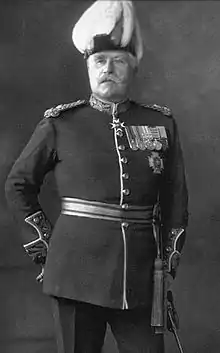William Pitcairn Campbell
Lieutenant General Sir William Pitcairn Campbell (or Pitcairn-Campbell), KCB ADC (20 June 1856 – 22 September 1933) was a British Army General during World War I.
Sir William Campbell | |
|---|---|
 General Sir William Pitcairn Campbell | |
| Born | 20 June 1856 |
| Died | 22 September 1933 (aged 77) |
| Allegiance | |
| Service/ | |
| Rank | Lieutenant General |
| Commands held | 3rd Brigade 5th Division Southern Command Western Command |
| Battles/wars | Second Boer War World War I |
| Awards | Knight Commander of the Order of the Bath |
Early life
He was the son of James Pitcairn Campbell and his wife, Eleanor (née Eyre), of Burton Hall, Neston. He had two elder sisters, Eliza and Georgina. He was educated at Windlesham House School, Eton College and the Royal Military College, Sandhurst.[1][2]
Military career
William Campbell was commissioned into the King's Royal Rifle Corps in 1875.[3] He served with the Mounted Infantry Camel Corps in Sudan between 1884 and 1885.[3][4] His battalion served in South Africa between 1899 and 1901 during the Second Boer War. At the Battle of Talana Hill he was wounded and his commanding officer was killed. As second in command, he took command of his battalion and was part of the garrison besieged at Ladysmith.[4] He was subsequently promoted to Lieutenant Colonel in command of the 1st Battalion on 25 January 1900.[3][5]
He was Aide-de-camp to King Edward VII from 1900 to 1907 and was made a Companion of the Order of the Bath in the King's Birthday Honours of 1906.[1][6]
He was appointed Commander 3rd Brigade in 1904 and General Officer Commanding 5th Division in 1909.[3] He moved on to be General Officer Commanding-in-Chief of Southern Command from 1914 and General Officer Commanding-in-Chief of Western Command from 1916; he retired in 1918.[3]
He received his knighthood in 1915 through promotion to Knight Commander in the Order of the Bath.[7][4]
In 1916, he was appointed Colonel of the Highland Light Infantry, succeeding General Sir Henry Hildyard.[8][9]
Family
In 1888 a fellow infantry officer, Major Gilbert, who had been serving in India named him as co-respondent in the divorce case against his wife. The following year, he and Edith Gilbert (née Prothero) married and went on to have one daughter.[10][11]
References
- Malden, Henry C. (1902). Muster Roll. Windlesham House, Brighton. A.D. 1837 to 1902 (2nd ed.). Brighton: H. & C. Treacher.
- "Sir W.P. Campbell: Death of Former G.O.C., Western Command". Western Morning News. 23 September 1933.
- "Sir William Pitcairn Campbell". Liddell Hart Centre for Military Archives.
- "Death of Sir Wm. Pitcairn Campbell". Cheshire Observer. 30 September 1933.
- "No. 27160". The London Gazette. 2 February 1900. p. 694.
- "Lieutenant-General Sir William Pitcairn Campbell (1856–1933)". lafayette.org.uk. Retrieved 19 January 2019.
- "The King's Birthday. List of Honours". The Globe. 29 June 1906.
- The Highland Light Infantry: Succession of Colonels 1777–1957 at britisharmedforces.org
- Light Infantry Regiments
- Lt.-Gen. Sir William Pitcairn Campbell The Peerage.com
- England & Wales, Civil Divorce Records, 1858–1916. Kew, Surrey: The National Archives of the UK. 1916.
| Military offices | ||
|---|---|---|
| Preceded by Herbert Plumer |
General Officer Commanding the 5th Division 1909–1913 |
Succeeded by Sir Charles Fergusson |
| Preceded by Sir Horace Smith-Dorrien |
GOC-in-C Southern Command 1914–1916 |
Succeeded by Sir Henry Sclater |
| Preceded by Sir Henry Mackinnon |
GOC-in-C Western Command 1916–1918 |
Succeeded by Sir Thomas Snow |